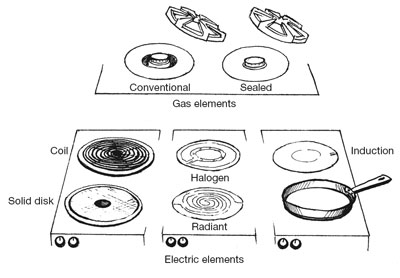Reasons to consider purchasing a new range, cooktop, or oven may include a substantial change in cooking practices, failed or broken equipment, or replacement of an older gas range with a standing pilot light. If you are ready to buy a new appliance, first determine whether or not you would prefer to have your cooktop separate from your oven (or ovens). Stand-alone cooktops have grown in popularity in recent decades and have little to no impact on energy use. You must also make choices about size, fuel (gas or electric), and what cooktop element and oven type are most appropriate for your needs. Design options for cooktops and ovens are treated separately here, but the considerations apply equally to ranges, which combine the two in one unit.
Fuel Choice: Gas or Electric?
Cooktops are widely available for either electric or gas cooking. Gas burners are often preferred by people who like to cook because gas offers a greater level of control in the speed of cooking. A downside to gas cooking appliances is that gas combustion products are introduced into the house and must be vented to the outside. Operate a ventilation fan that vents to the outside when using a gas cooktop or oven.
Cooktop Types
Gas Elements
There are two types of gas burners available: conventional burners with electric ignition (the most common), and sealed burners, where the burner is fused to the cooktop. In the U.S., standing pilots are no longer allowed on any gas cooktops, ranges, or ovens. This is a positive development since standing pilots can more than double the annual energy consumption of a cooktop or range because they are continuously burning a small amount of fuel, even when you’re not cooking. When comparing sealed to unsealed burners, there is no measurable difference in cooking efficiency, although sealed burners are simpler and easier to clean.
Electric Elements
With electric cooktops, a number of different burner types are available, some of which offer energy savings and greater cooking control. The most common electric burners in this country are exposed coils, but you can also buy models with solid disk, radiant, halogen, or induction elements.
Radiant elements and halogen elements offer a level of efficiency just a bit higher than standard resistance coils. This is because they involve a heating source under a ceramic glass surface that provides for more rapid and even heat transfer. They are also easier to clean and generally more aesthetically appealing. Compared to standard resistance coils, these elements will likely add a few hundred dollars to the price of a new cooktop, although prices vary widely.
Solid disk elements are the least efficient electric cooktop design. They heat up more slowly than coil elements and generally use a higher wattage. It is especially important to use flat-bottomed cookware with these elements in order to minimize wasted energy.
Induction elements are the newest and most innovative type of electric cooktop in the North American market. Induction elements transfer electromagnetic energy directly to the pan where the heat is needed and offer greater control than conventional electric elements. As a result, they are very energy efficient — using 30% less energy than standard electric coil elements while introducing less heat into the kitchen than conventional gas or electric designs. One catch is that they work only with ferrous metal cookware (cast iron, stainless steel, enameled iron, etc.). Aluminum or copper cookware will not work. When the pan is removed, there is almost no lingering heat on the cooktop. To date, induction elements have been available only with the highest-priced cooktops, but more and more manufacturers are adding them to their product lines at lower price points. Freestanding countertop units with one to four burners are also available.
Oven Type
In addition to standard electric and gas ovens, there are now convection ovens, microwave ovens, and combination models that work in one or more modes.
Conventional Ovens. With standard gas or electric ovens, self-cleaning models are more energy efficient because they have more insulation. But if you use the self-cleaning feature more than about once a month, you’ll end up using more energy with the feature than you save from the extra insulation. If you’re the type of cook who needs to peek into the oven all the time, buy a model with a window in the door and a light inside.
Convection Ovens. These can be more energy efficient than standard ovens because the heated air is continuously circulated around the food being cooked. You get more even heat distribution and, for many foods, temperatures and cooking time can be decreased. In some cases, you can cook multiple batches at the same time, cutting the additional energy consumption required for cooking each batch separately in a conventional oven.
Microwave Ovens. Microwaves are very high-frequency radio waves. In these ovens, the energetic waves penetrate the food surface and heat water molecules inside. Energy consumption and cooking times for certain foods are greatly reduced, especially small portions and leftovers. Overall, energy use is reduced by about two-thirds. Because less heat is generated in the kitchen, you may also save on air conditioning costs during the summer. Some microwave ovens include sophisticated features to further boost energy efficiency and cooking performance, such as temperature probes, controls to turn off the microwave when food is cooked, and variable power settings.
New “rapid-cook” ovens combining microwaves with other cooking technologies — notably halogen lights or convection — are designed to cut cooking time and improve the quality of foods compared to standard microwave preparation.


